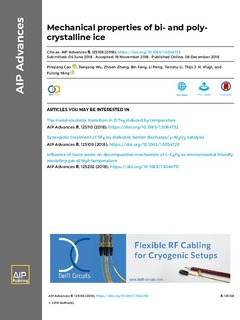| dc.description.abstract | A sound knowledge of fundamental mechanical properties of water ice is of crucial importance to address a wide range of applications in earth science, engineering, as well as ice sculpture and winter sports, such as ice skating, ice fishing, ice climbing, bobsleighs, and so on. Here, we report large-scale molecular dynamics (MD) simulations of mechanical properties of bi- and poly-crystalline hexagonal ice (Ih) under mechanical loads. Results show that bicrystals, upon tension, exhibit either brittle or ductile fracture, depending on the microstructure of grain boundaries (GBs), whereas they show ductile fracture by amorphization and crystallographic slips emitted from GBs under compression. Under shearing, the strength of bicrystals exhibits a characteristic plateau or sawtooth behavior drawn out the initial elastic strains. Nanograined polycrystals are destabilized by strain-induced amorphization and collective GB sliding. Their mechanical responses depend on the grain size. Both tensile and compressive strengths decrease as grain size decreases, showing inverse Hall-Petch weakening behavior. Large fraction of amorphous water structure in polycrystals with small grain size is mainly responsible for the inverse Hall-Petch softening. Dislocation nucleation and propagation are also identified in nanograined ice, which is in good agreement with experimental measurements. Beyond the elastic strain, a combination of GB sliding, grain rotation, amorphization and recrystallization, phase transformation, and dislocation nucleation dominate the plastic deformation in both bicrystals and polycrystals. | nb_NO |

